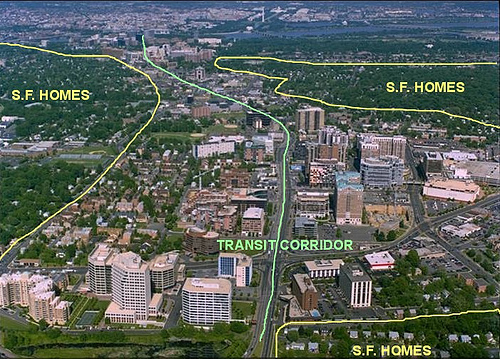The Jury Chairman’s Test of Time Award is given to the Rosslyn-Ballston Corridor, a highly successful integration of transit-oriented development and neighborhood preservation along the MetroRail corridor serving the heart of Arlington County, VA.
Early Charter Awards leaned heavily toward designed rather than built projects, reflecting the growing pains of a new movement without much built legacy. Over time, the proportion has shifted towards completed projects. The merits and lessons of many early New Urbanist projects are now apparent.
With support of the CNU Board, staff, and 2016 Charter Awards jury, this special award selected by the Jury Chair honors an enduring project that has substantially improved quality of life and prosperity.
The following criteria were applied: The project or some part of it must have been recognized in a previous Charter Award, it must be of a substantial duration, and it must have had a significant positive impact.
The Rosslyn-Ballston Corridor has all the right elements in outstanding colors: sustained political consensus over decades, benefits shared and adjacent neighborhoods protected, clear planning and design guidance creating a market for higher density and street-based urbanism around transit, an impressive improvement in the County’s tax base, a shift to transit and walking, and improved quality of life.
Clarendon Center, a project in the corridor, received a Charter Award in 2013 for its mix of new and historic buildings, the extensive community involvement, and the way that it leveraged its location next to MetroRail on the Rosslyn-Ballston Corridor.
Rough Plan of the Rosslyn-Ballston Corridor.Since 1996, Arlington has added more than 45,000 new residents and millions of square feet of commercial and office space. “Today, Arlington has more office space than Downtown Dallas, and the highest concentration of 24-to-34 year olds in the country,” The Washingtonian writes. Because most development has been walkable to Metro stations or along high-volume bus corridors, traffic has remained steady or declined. Wilson Boulevard, Arlington’s busiest, densest corridor and Clarendon’s main drag, saw a 23 percent decline in motor vehicles from 1996 to 2012, according to the county.
A case study by Dennis Leach for the 2005 book New Transit Town, edited by Jury Chair Hank Dittmar and Gloria Ohland, found a non-automobile mode share of 47 percent, broad community acceptance, and that the corridor generated 33 percent of the county tax base on only 8 percent of its land.
For its innovation, enduring consensus, and positive outcomes, the Rosslyn-Ballston Corridor deserves a Test of Time Award.
Photo above: Streetscape of the Rosslyn-Ballston Corridor.
Project Details
Rosslyn-Ballston Corridor Arlington, Virginia
Year
Ongoing

